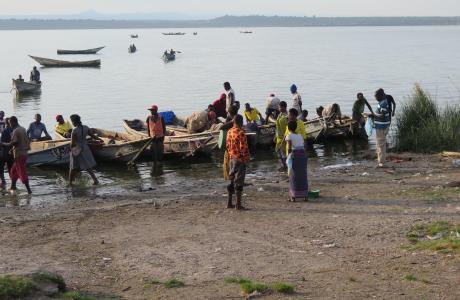Slow-moving landslides a growing, but ignored, threat to mountain communities

The large slow-moving landslide of Funu in Bukavu in 2018. The very steep scarp that delimits the upper part of the landside is 100 meters high. All the settlement before this scarp are in the landslide.
© A. Dille, AfricaMuseum
When people hear the word ‘landslide’, they often think of the sudden collapse of earth or rock from a mountain. But slow-moving landslides – which can move as little as one millimeter per year and up to a few meters per year – are also a growing threat to people who are pushed to live on steeper slopes because of urban growth and flood risk.
These findings by a team of researchers from several institutions, including the AfricaMuseum, have just been reported in a new study on how human settlement pressure drives exposure to slow-moving landslides.
In all regions in the study, the growth of urban centers is associated with an increase in exposure. As a city’s footprint expands, new growth may be forced to occur in hillslopes with slow-moving landslides. This increased exposure mostly affect the poorest who often have no choice but to settle in these unstable slopes, the authors point out.
Slopes with slow-moving landslides may seem safe to settle on. The slide itself may be inconspicuous or even undetected, but as it creeps along, houses and other infrastructure can be damaged. Sudden acceleration can worsen such damage and, rarely, lead to fatalities. Olivier Dewitte, a natural hazard researcher of the AfricaMuseum and a co-author of the study, explained that in Bukavu for example, a city in the Democratic Republic of the Congo, the neighbourhood of Funu where 80,000 people live, often in poor conditions, is exposed to such a slow-moving hillslope.
With nearly 1.3 billion people living in mountainous regions, the potential global exposure to slow-moving landslides is high. ‘Our mountain populations face growing landslide and flood risks, exacerbated by climate change,’ said Joaquin Vicente Ferrer, a natural hazards researcher at the University of Potsdam and lead author of the study. ‘Deepening our understanding of how growing flood hazards and urbanization can drive communities onto unstable slopes will be crucial to manage exposure and mitigate disaster risk.’
This study is published in Earth’s Future, an open-access, peer-reviewed AGU journal. View and download a pdf of the study here.
Ferrer, J.V., Samprogna Mohor, G., Dewitte, O., Pánek, T., Reyes‐Carmona, C., Handwerger, A.L., et al. (2024). Human settlement pressure drives slow‐moving landslide exposure. Earth's Future 12 (9) : e2024EF004830


